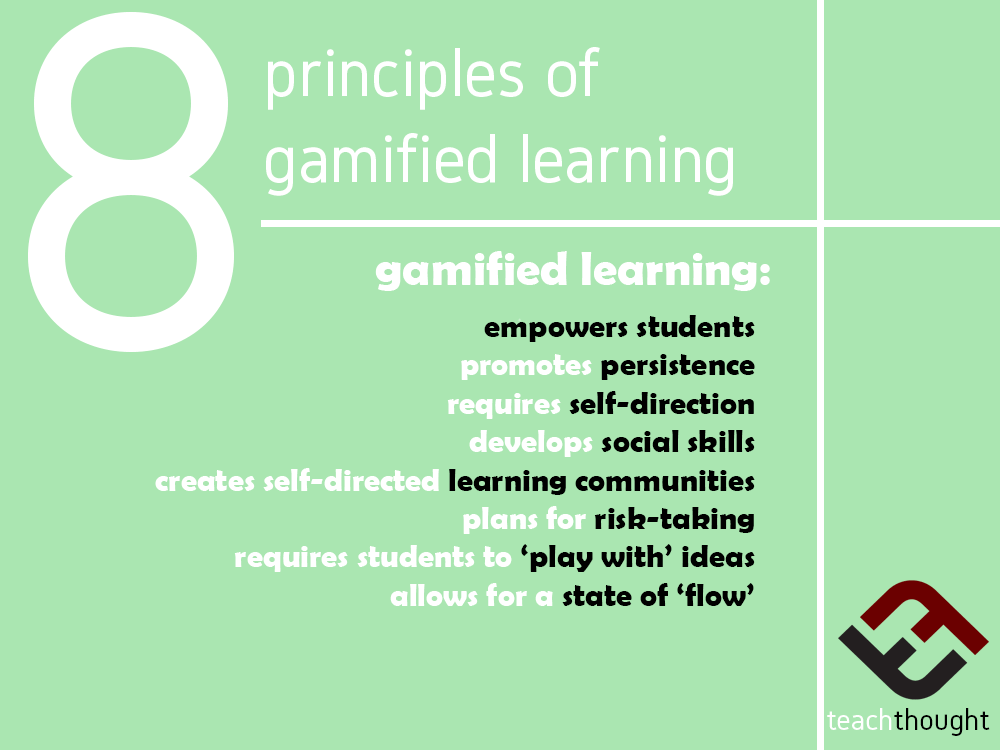
8 Principles Of Gamified Learning
contributed by Jonathan Cassie
As our society continues to evolve in response to the rapid changes brought on by universally accessible mass technology, the act of teaching (and the experience of learning) has been under significant pressure to adapt. Since the turn of the century, a number of approaches have been offered by scholars and practitioners to answer this challenge. One of them that I feel strongly is an essential part of the educator’s toolbox is gamified instruction.
Simply put, industrial-age instructional techniques leave many information-age students in the dust. Gamified instruction uses the mechanics, engines, and underpinning strategies games use to encourage play to encourage learning. It is one method among many that teachers might embrace to leverage the Millennial mindset and the unique power of games to sustain interest and build commitment.
In my book, Level Up Your Classroom, I develop eight research-informed principles that support gamified instruction as an approach to teaching and learning. These eight principles are:
Gamified instruction empowers students to own their learning.
Students who learn in a gamified classroom have a better capacity for persistence.
Self-direction is obligatory in a gamified classroom and is developed by all games.
Gamified instruction develops social skills.
Gamified instruction encourages students to build self-directed learning communities.
Risk-taking is encouraged by the democratic and meritocratic nature of gamified instruction.
A playful approach to learning is a natural consequence of gamified instruction.
A powerful sense of flow is an inherent part of gamified instruction
Gamified instruction is not game-based learning (GBL). (Read more about the difference between gamification and game-based learning.) In GBL, a teacher uses a board, card, or video game right out of the box. Students play the game and in the course of play learn whatever it is the game is designed to teach. There’s nothing inherently wrong with this approach, but it isn’t gamified instruction.
In a gamified classroom, the teacher’s work starts with the learning objective–the goal or intent of instruction. What skills, knowledge, or habits of mind is the teacher interested in imparting through the lesson at hand? If this lesson might be suitable for gamification (not all lessons are), the teacher needs to consider specific kinds of games that offer mechanics that can be mined for the teacher’s gamified purpose. What might that look like?
One of the most popular board games of the past year is called Machi Koro. In Machi Koro, the players are building the economic framework of a city. Players win by constructing four buildings called ‘landmarks’ using money they earn from other buildings they erect in their city. There are hundreds of combinations of buildings players might use to earn money and there’s no requirement that they build anything in particular, except the four landmarks. On their turn, a player rolls one or two 6-sided dice and that triggers the effects of buildings that have a value that matches what was rolled. The first player to have earned enough money to build the fourth landmark wins once it’s built and the game ends. That is Machi Koro’s engine. How might that translate to a lesson?
Imagine trying to teach the Salem Witchcraft Crisis to middle school students. Salem was a complex social, religious, political, gender-based phenomenon that caused the deaths of 20 innocent people and the accusation of hundreds. The teacher using the Machi Koro engine might replace the landmark buildings with key events in the history of the crisis and also replace the city buildings that generate money with people, places, and events in history that contributed to either exacerbating the crisis or mitigating it. Students would then play the game just like Machi Koro is played, buying events and places that lead to the landmark events in 1692 that distinguish the Salem crisis.
Indeed, the teacher might first have students play with cards that accelerate the crisis and learn how hysteria develops. Students might then flip and play with cards that mitigated the crisis and learn how a society undoes mass hysteria. The teacher would end the lesson with a piece of reflective writing or give students an assignment to record a two-minute video sharing their takeaways and experience.
In this way, students have learned a lesson about Salem in a way that encourages critical thinking and expansive thinking.
To learn more about applying gamified principles to your instruction, listen to this episode of the ASCD Learn Teach Lead Radio podcast with Jonathan Cassie.
Jonathan Cassie is the author of Level Up Your Classroom: The Quest to Gamify Your Lessons and Engage Your Students. Cassie is head of the senior school at Sewickley Academy, just outside Pittsburgh, and has taught history, English, Latin, and game design at schools in Dallas, Los Angeles, and Pittsburgh. Throughout his 20-year career in independent schools, he has been a student and practitioner of innovation and change in education.
